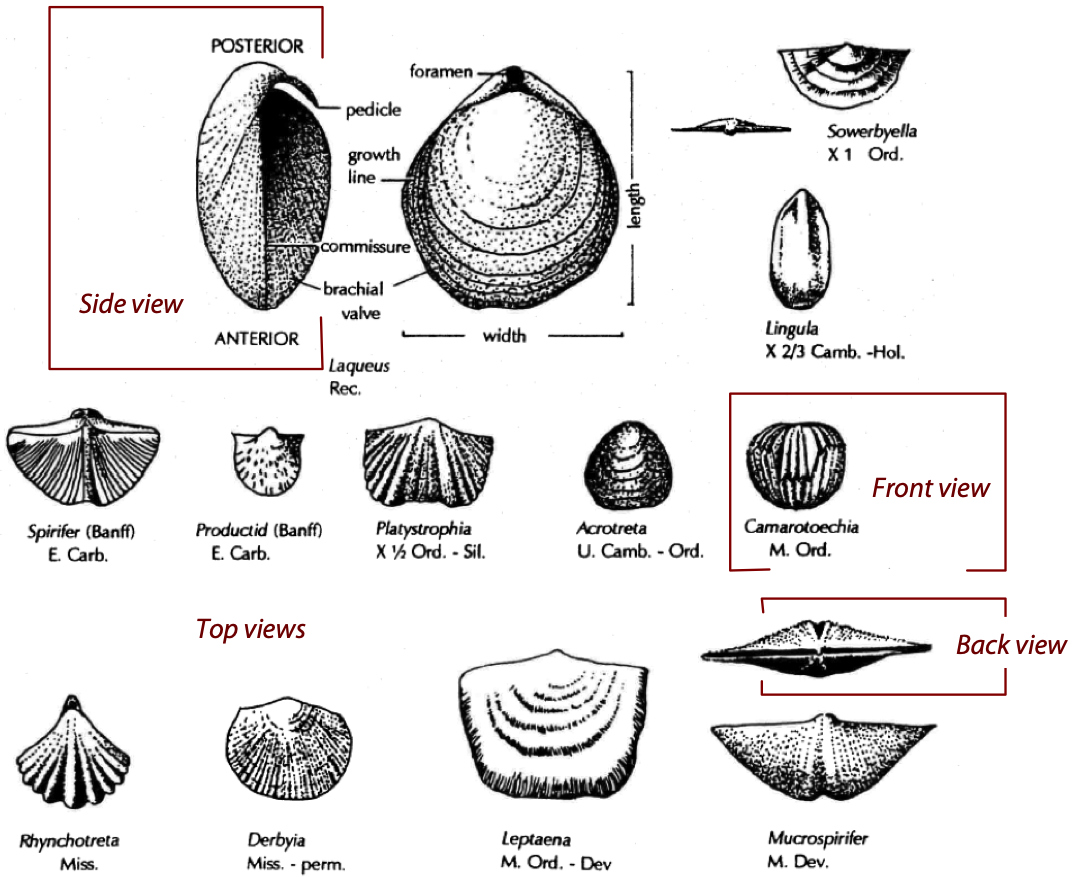Fossils of the Paleozoic: Phylum Brachiopoda (The Brachiopods)
Brachiopods (Figure 7.9) range from the Lower Cambrian to the present. They were at peak diversity in the Devonian, but most went extinct at the end of the Permian. Brachiopod fossils are often well-preserved, as well as being abundant and exhibiting diverse shell morphology (i.e., a variety of shell shapes) over time. Because of these characteristics and their long presence in the geologic record, they are perhaps the best index fossil for correlation and relative time dating.

Brachiopods are animals that live inside two shells (or valves) that show bilateral symmetry from side to side (i.e., if viewed from above or below). The top and bottom shells are not the same shape. To see this, look at the Side view in Figure 7.9: the valve on the left is the top and the valve on the right is the bottom.
The animal attaches itself to the sea bottom by a pedicle (a muscle sometimes referred to as a “foot”) that extends through an opening near the shell’s hinge. The animal draws water in, filters out food (mostly phytoplankton), then expels the water. The animal must exert muscle power to open the shells, and when their muscles are relaxed the shells close. As a result, fossil brachiopods are frequently found with both sides together. This is different from the bivalves introduced in the next section.
Brachiopod shells vary greatly in shape and texture. They are typically 2 to 4 cm in size, but some are 6 to 8 cm and a few reach up to 25 cm across.
Questions a & b
a. Describe the brachiopod habit using terms from Figure 7.2.
b. What environment range do brachiopods occupy? (Refer to Figure 7.4)
A. Sample 13: Brachiopod
These samples can be picked up but please treat them with care.
The ripples on the surface of this sample are referred to as corrugations. They have the same purpose as the rippled inner layer of corrugated cardboard.
Questions c-f
c. Make a simple sketch of Sample 13 from above (Slide 1) and from the front (the side that opened; Slide 2). Identify the plane of symmetry on your sketches.
d. What type of symmetry does this fossil have?
e. Describe how this was fossil preserved, and name the preservation type.
f. Which morphological characteristic (i.e., which aspect of the shape) of this sample indicates the strength of the shell?
Examine Samples 9 and 15 below, paying special attention to the shape and structure of the shell.
B. Sample 9: Brachiopod
These samples can be picked up but please treat them with care.
C. Sample 15: Brachiopod
These samples can be picked up but please treat them with care.
Question h
